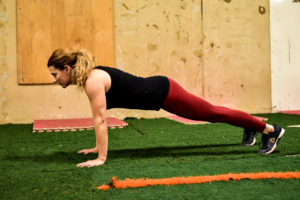
In CrossFit, we progress in this order: Mechanics, Consistency, and then Intensity. Following this progression will allow you to get the full benefits of what we offer in classes. Let’s breakdown by what we mean by each of those terms:
Mechanics
The first step in any fitness journey is to learn to perform basic movement mechanics. Movement mechanics refers to technique – your understanding and ability to move you and external objects in the most efficient, effective, and safe manner possible. Most people can immediately appreciate the importance of the technique because it is what keeps you free from injury during exercises. Thus it is critical that anyone joining our program develop sound movement mechanics before pushing for intensity in the form of load, high reps, or rapid execution.
Range of Motion (ROM)
Range of motion is the full amount, both distance and direction, a joint can move or in which a movement is performed to a standard. Full, or functional, ROM is complete movement in the entirety of the distance and direction a joint can move.
Functional ROM
The CrossFit protocol is 1) constantly varied 2) functional movements 3) executed at high intensity. A functional movement is a movement that can be applied “out there” in your everyday life. If you train half-depth squats you miss out on getting stronger where it counts in real life – standing up from a seated position. Or consider the pushup (a common poorly executed movement) – what happens when you have to get up off the ground and you’ve only ever done a half pushup or bench press? What if you have to get up and down really fast? Repeatedly? The goal of CrossFit is to make you more functionally capable and that is only accomplished by using our joints to their full, functional ROM.
ROM Increases Flexibility and Work Capacity
In addition to increased functional ability, working joints to their full ROM maintains flexibility. For athletes that spend the majority of their time at a desk, doing full-depth squats and pushups to the floor will maintain the flexibility of the hips and shoulders. For athletes that have old injuries that have led to decreased flexibility (the shoulder is a common one), working the joint to its fullest ROM will often increase flexibility.
When we extend our joints a little bit further on a floor-to-chest push-up versus a three-inch-off-the-deck push-up, we get more work done in every rep. One full ROM push-up is more than twice as hard as one half-push up. Doing full ROM during your exercises is going to increase the amount of work done in the workout.
ROM and Workouts
Finally, we want you to be your best. During a workout, our coaches will define the movement standards required for the workout – or the ROM requirements. We take the ROM standards seriously. They are what keep our athletes safe as well as what helps them progress. The coaches will make sure you are aware of any deficiencies in your ROM.
Final notes
We understand that there are always exceptions to every rule. Sometimes injury or flexibility issues can prevent you from completing a movement to full ROM. If this is the case, please make sure your coach is aware so they can help you modify for the workout – our goal is a pain-free range of motion. When appropriate, we can also suggest other exercises to help gain back some mobility in the compromised joint.
If you’re interested in learning more about our coaching programs and how we can help you be your best – Click HERE

